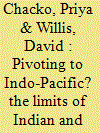| Srl | Item |
| 1 |
ID:
160609


|
|
|
|
|
| Summary/Abstract |
Proponents of the Indo-Pacific concept assume that growing economic and societal linkages and the need for greater political and security cooperation and order-building are leading to the integration of the region. India and Indonesia were thought to be crucial in these processes of regionalisation and regionalism and were early adopters of the Indo-Pacific idea. The purpose of this paper is to evaluate the extent to which the Indo-Pacific initiatives of India and Indonesia are leading to the integration of the Asia-Pacific and Indian Ocean regions through greater Indian involvement with the Pacific region and stronger Indonesian engagement with the Indian Ocean region. It is argued that an interlinked set of security and economic concerns drove India and Indonesia’s adoption of the Indo-Pacific idea. In both cases, a desire for economic growth and preventing Chinese economic and political dominance in the region were important drivers. However, the nature of the political economies of India and Indonesia does not readily facilitate extensive economic linkages or strategic interests beyond their immediate regions. Moreover, both countries are wary of being seen as members of anti-China coalitions due to the impact this may have on regional stability and their domestic political and economic priorities. These factors place significant limitations on the regional integration of the Indo-Pacific.
|
|
|
|
|
|
|
|
|
|
|
|
|
|
|
|
| 2 |
ID:
165214


|
|
|
|
|
| Summary/Abstract |
Since the 1950s, US strategic architecture in the Indo-Pacific has been premised on its hubs-and-spokes model of bilateral alliances and security partnerships. Since the 2000s the US began working toward forging deeper interrelationships between its regional allies and partners. The emerging strategy ultimately aims to interlink long-standing allies like Japan and Australia, and also non-traditional partners in the development of a security network capable of maintaining the regional ‘rules-based order.’ In analysing the US-led triangular Indo-Pacific geometry, this article considers the prospects of an evolving and substantive US–Australia–Indonesia security trilateral. It does so by utilising Miller’s ‘conditions for cooperation framework’ to test the likelihood of greater cooperation between these three states. These conditions include cultural similarity, economic equality, habits of international association, the perception of common danger, and greater power pressure. It concludes that while there remain strict limitations on any formal alignment between the ANZUS partners and Indonesia, there are convergent interests in key sub-strategic areas in the maritime space and thus a viable path toward greater trilateral cooperation but not, as yet, formal arrangements.
|
|
|
|
|
|
|
|
|
|
|
|
|
|
|
|